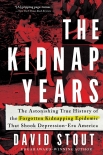The Kidnap Years:, David Stout [readict .txt] 📗

- Author: David Stout
Book online «The Kidnap Years:, David Stout [readict .txt] 📗». Author David Stout
Anna Hauptmann continued her futile attempts to prove her husband innocent of the Lindbergh kidnapping before she faded into obscurity. She died in 1994 at age ninety-five.
Charles Boettcher, who was kidnapped in 1933 by Verne Sankey and accomplices, was found dead by his wife, Mae, in 1963. He apparently had had a heart attack. He was sixty-one. Boettcher’s first wife, Anna, who had been all but ignored as her husband returned home from his kidnapping ordeal, had committed suicide in 1941.
William Hamm, kidnapped in 1933 by the Barker-Karpis gang, died in 1970. He was eighty-seven. Edward Bremer, another prominent kidnapping victim of the Barker-Karpis gang, died of a heart attack in 1965 as he was emerging from a swimming pool at his summer home in Florida. He was sixty-seven.
Jake “the Barber” Factor, the supposed victim in a “kidnapping” that probably never occurred, died in 1984. He was ninety-one.
Charles Urschel, the fabulously wealthy oil tycoon kidnapped in 1933, died at eighty in 1970. The man who engineered the kidnapping, George “Machine Gun” Kelly, spent seventeen years in Alcatraz, where he earned the nickname “Pop Gun” Kelly because of his friendly demeanor and model behavior. In 1951, he was transferred to Leavenworth prison, where he died of a heart attack on July 18, 1954, his fifty-ninth birthday.
Basil “the Owl” Banghart served a long stretch in Alcatraz where he worked in the kitchen with Alvin “Creepy” Karpis. Eventually, Banghart was transferred back to the Illinois state prison. The kidnapping charges against him in the Factor case were dropped, and he was released in 1960. He spent much of his later life living quietly on an island in Puget Sound and died in 1982 at age eighty.
Alvin Karpis is said to have served the longest sentence of any inmate at Alcatraz, twenty-six years. In 1962, as the federal government was preparing to close the prison, he was transferred to McNeil Island Penitentiary in Washington State. Paroled in 1969, he moved to Montreal, then settled in Spain in 1973. He died there on August 26, 1979, at seventy-two.
While he was at McNeil Island, Karpis showed a softer side. He also became a link, in a way, between two vastly different eras.
As Karpis told the writer Robert Livesey, who collaborated with Karpis on the gangster’s 1980 autobiography, a young prisoner approached him one day and mused that he would like to take music lessons. Karpis learned that the young man had been in institutions much of his life—orphanages, reformatories, and finally prisons—after a childhood utterly lacking in stability and parental guidance. So Karpis became protective of the young man, finding his personality pleasant enough, and rather mild for a convict. The young prisoner’s name was Charles Manson.
J. Edgar Hoover in 1924.
Photo © Library of Congress
Charles Lindbergh at the trial for Bruno Richard Hauptmann.
Photo © Library of Congress
The Lindbergh baby ransom note.
Photo © FBI
Charles Augustus Lindbergh Jr., whose kidnapping and murder became known as “the crime of the century.”
Photo © FBI
Charles Boettcher and his wife, Anne.
Photo © Stephen H. Hart Library, Colorado Historical Society
Charles Boettcher in his robe the morning after he was freed from his kidnappers.
Photo © Stephen H. Hart Library, Colorado Historical Society
A portion of Charles Boettcher’s ransom note.
Photo © Stephen H. Hart Library, Colorado Historical Society
Verne Sankey, the man who kidnapped Charles Boettcher.
Photo © Stephen H. Hart Library, Colorado Historical Society
An arsenal of weapons at Ma Barker’s hideout.
Photo © FBI
Kate “Ma” Barker.
Photo © FBI
Frederick Barker, the youngest son of Ma Barker and one of the founders of the Barker-Karpis gang.
Photo © FBI
Arthur “Doc” Barker, the son of Ma Barker and a member of the Barker-Karpis gang.
Photo © FBI
Depression-era gangster Alvin Karpis.
Photo © FBI
Alvin Karpis’s fingerprints, which he had altered to avoid detection.
Photo © FBI
Kidnapping victim Haskell Bohn and his father.
Photo © Minnesota Historical Society
William Hamm (right) and his brewery manager, W. W. Dunn.
Photo © Minnesota Historical Society
Edward Bremer and his father, Adolph.
Photo © Minnesota Historical Society
READING GROUP GUIDE
1. Prior to reading this book, how much did you know about the lawlessness of the Great Depression? Did you recognize any of the cases covered in the book?
2. How do you feel about the kidnapping of Buppie Orthwein by Charles Abernathy, where the kidnappers were not cruel or malicious, merely desperate? Discuss your feelings regarding crimes like these. Are they comparable to violent kidnappings? Should these crimes be treated similarly?
3. Before the advances in forensic science and technology of today, investigating violent crimes was especially difficult. Were there any investigations that you found impressive? Which ones did you find lacking?
4. Discuss which unsolved cases you think could be solved by modern-day forensics.
5. Some instances of kidnapping, like Marion Parker’s, are especially gruesome. Which cases were the most difficult for you to read about?
6. During the “kidnap years,” it became common for people to be taken from their homes, schools, and places of work. Imagine you lived during this time. How would you feel going about your day-to-day routine?
7. While this kidnapping epidemic terrorized the States, they produced some positive results. Discuss the good that came out of such a dark history.
8. Many of these stories involve poorer people kidnapping wealthier ones. Given the desperate poverty suffered by many at the time, how do you feel about the motives behind some of these abductions? Does this change the way you think about crime and those who commit it?
9. As the kidnapping epidemic continued, people became violent in their fear, like when a mob took justice into their own hands by lynching Thurmond





Comments (0)